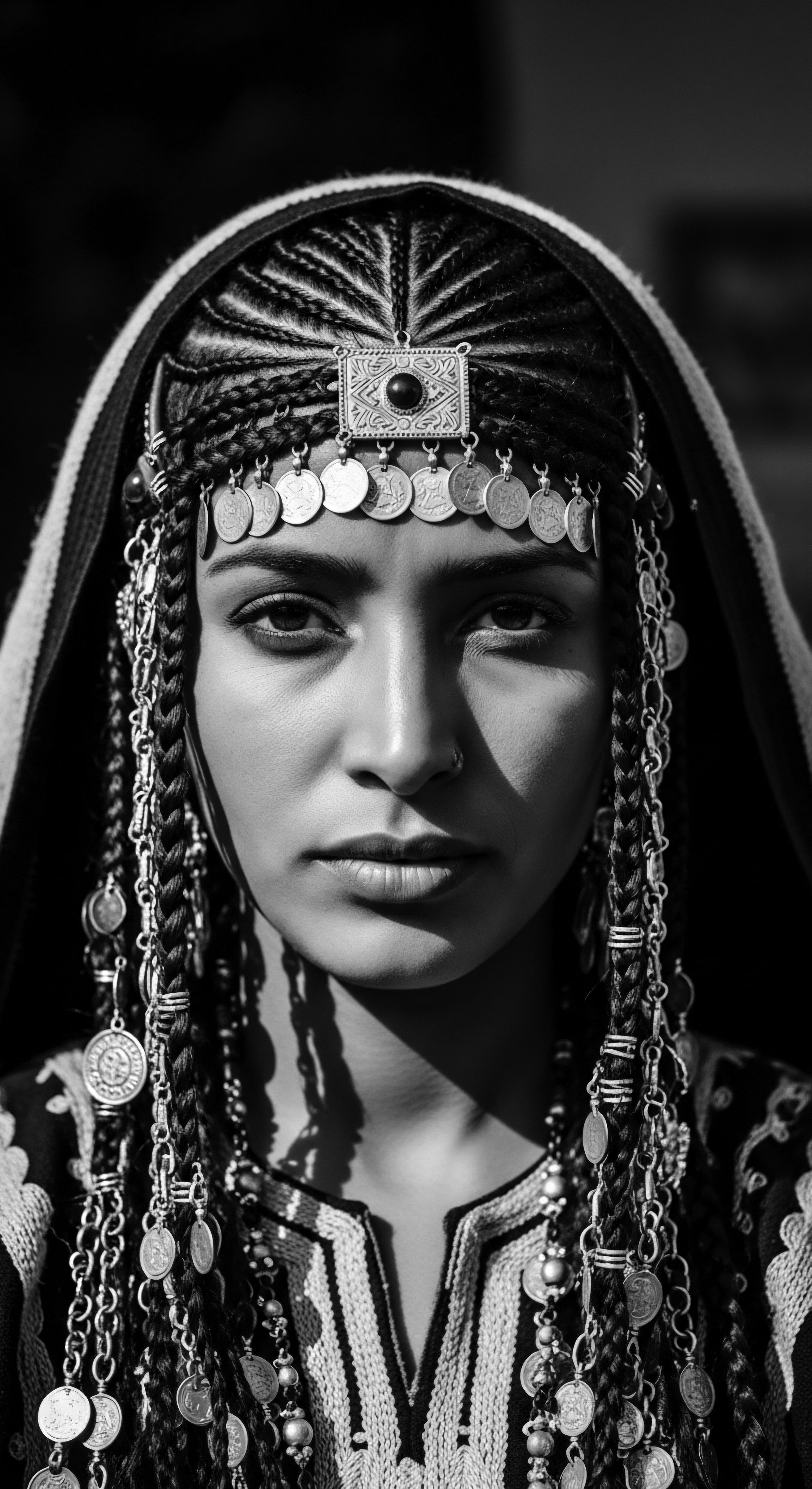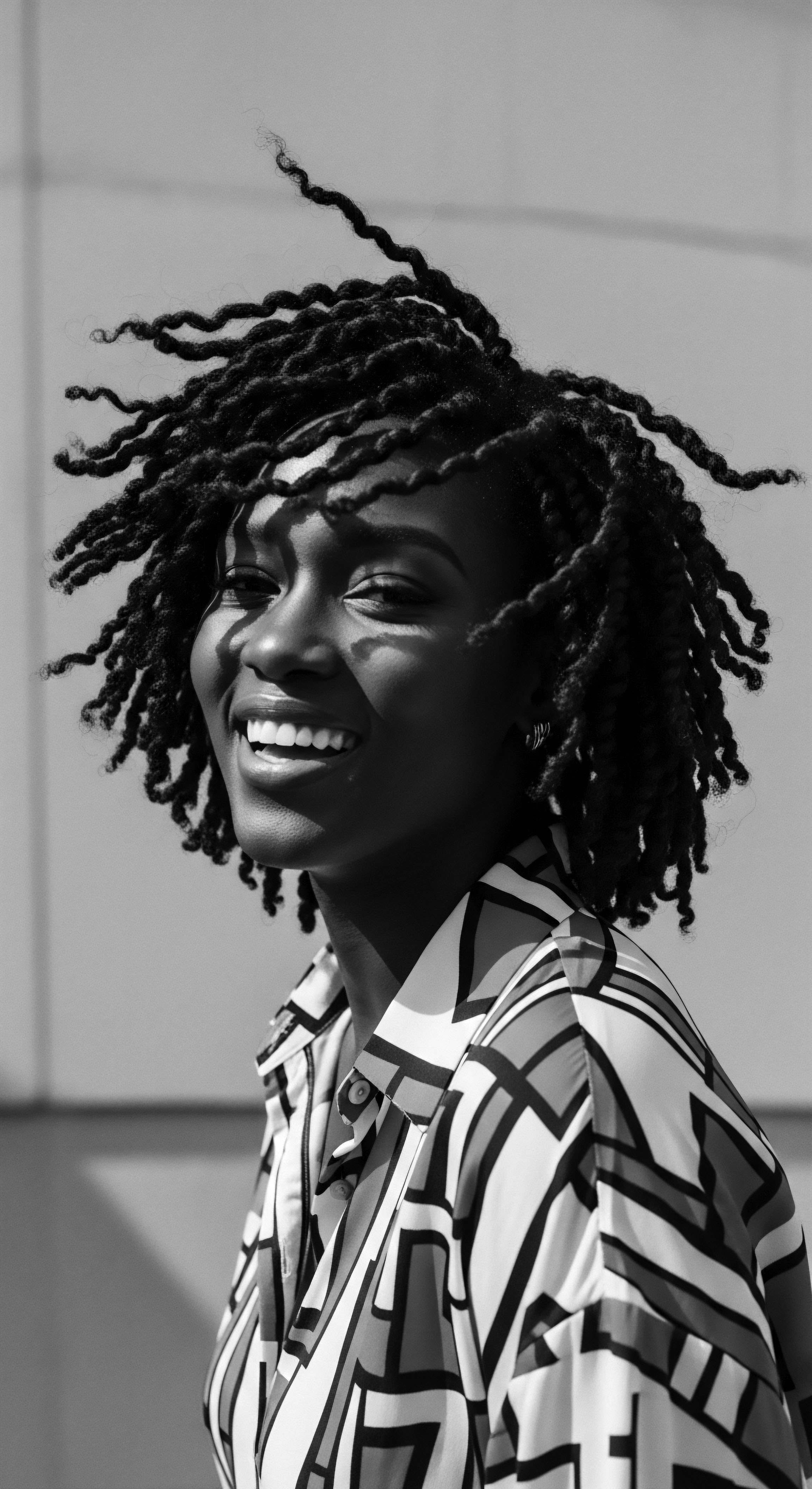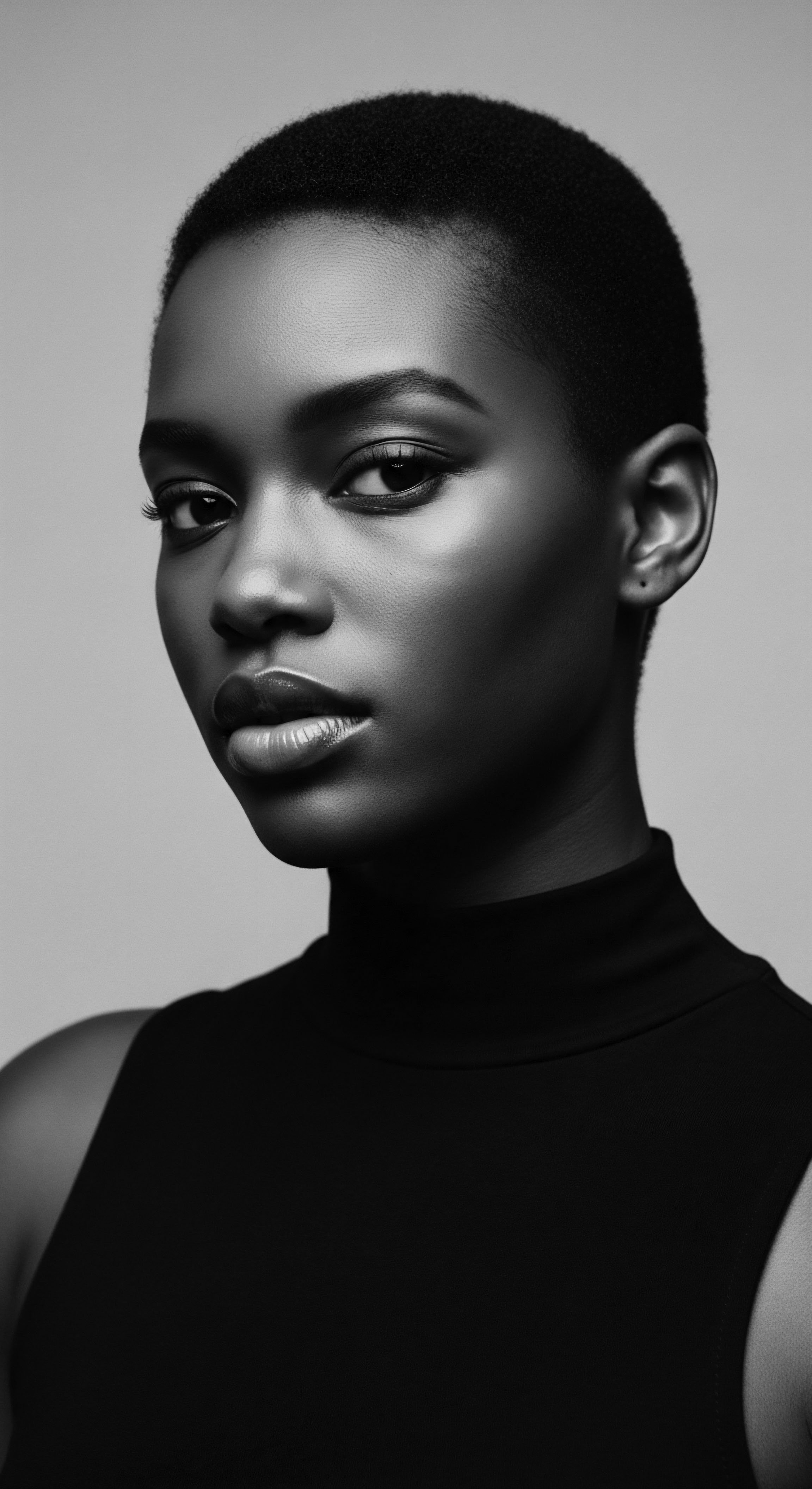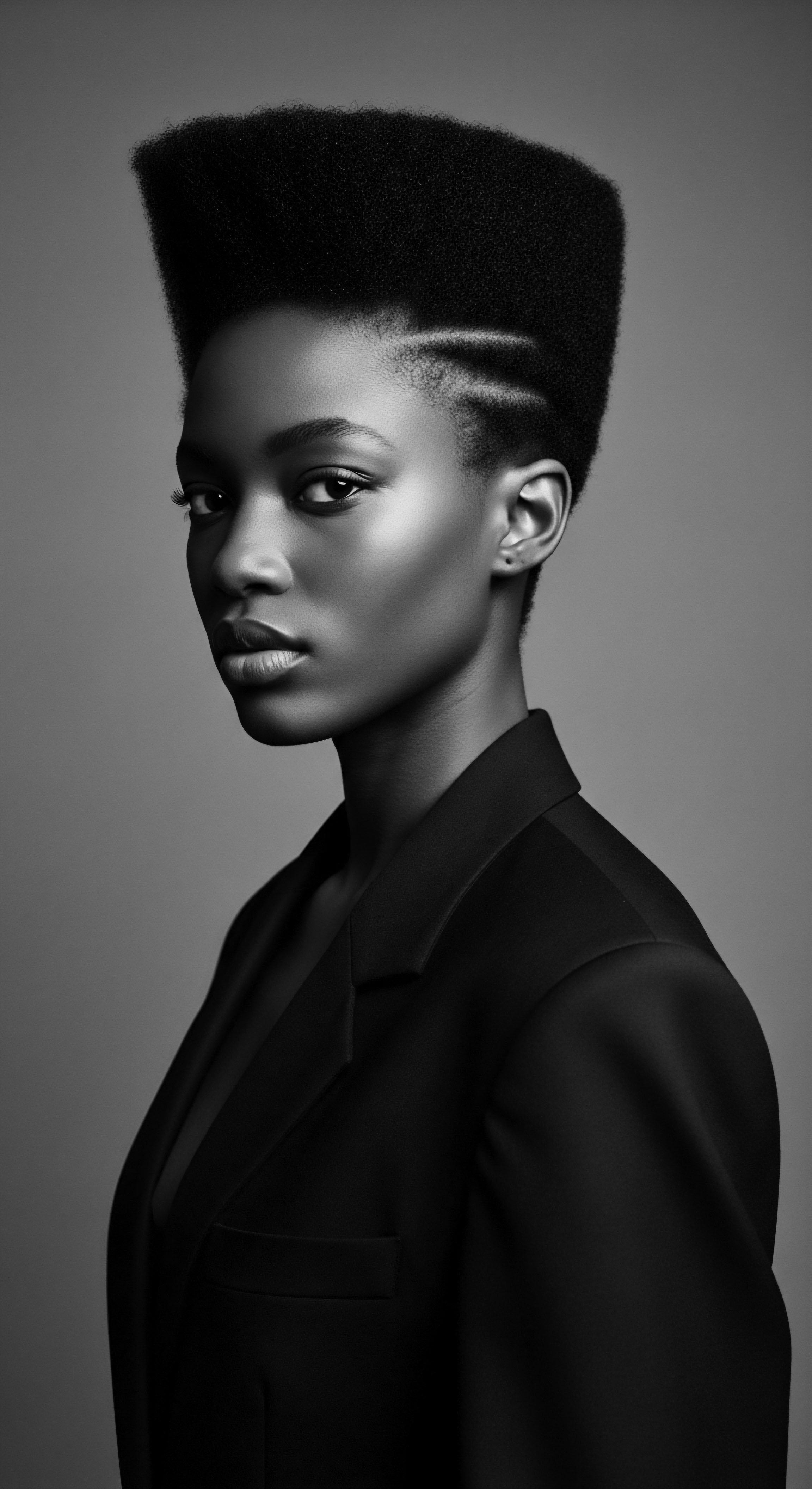
Roots
For those who carry the coiled brilliance, the deep spirals, and the resilient zig-zags of textured hair, there dwells within each strand a chronicle, an ancestral whisper. It speaks of earth, of sun, of hands that knew the rhythm of the seasons and the secret language of botanicals. Our present-day understanding of moisture needs for these vibrant crowns did not simply spring forth from modern laboratories or contemporary product aisles. Quite the contrary, it rests upon a bedrock of historical practices , knowledge passed through generations, and the sheer ingenuity of communities navigating their world with what nature provided.
To truly grasp the thirsty heart of textured hair, one must first look back, tracing the earliest traditions that tended to its unique structure. The very essence of what we now call hydration was, for centuries, an intuitive wisdom, a lived experience of care woven into daily life.

Hair’s Elemental Blueprint
Consider the anatomy of a hair strand. It is a marvel, a protein filament rising from the scalp, its shape dictated by the follicle’s curvature. For textured hair, this curvature is often elliptical or flattened, causing the hair shaft to coil, kink, or wave in myriad ways. This inherent shape means that the natural oils, or sebum, produced by the scalp, face a more circuitous route down the strand.
Where straight hair allows sebum a relatively unhindered glide, the twists and turns of a coil make the journey more challenging, leaving the ends particularly vulnerable to dryness. This biological reality, though articulated with modern scientific terms today, was keenly observed by our forebears. They didn’t have microscopes to view the cuticle layers, but they understood the visible consequences ❉ frizz, brittleness, and a lack of suppleness. This intuitive understanding formed the genesis of their moisture-focused rituals.
The very nomenclature we sometimes use for textured hair today – terms like ‘kinky,’ ‘coily,’ ‘wavy’ – while attempts at classification, often carry echoes of historical biases. Yet, beneath these labels lies a profound diversity that ancestral communities honored in their own ways. They understood that no two heads of hair were exactly alike, even within a single family or village. Their care systems, therefore, were fluid, responsive, and deeply personalized, adjusting based on apparent dryness or elasticity.

Ancestral Wisdom and Moisture
How did our predecessors discern moisture needs without clinical studies? They observed, they felt, they learned. A strand that snapped easily spoke of thirst. Hair that absorbed water quickly but dried just as fast revealed a certain porosity.
These were not abstract concepts; these were living indicators guiding their choices of emollients and humectants from their immediate environments. Long before the advent of chemical compounds, plant-based oils and butters were the foundational elements of hair vitality. These natural substances, rich in fatty acids and vitamins, served as both sealants and softeners , directly addressing the hair’s capacity to retain water.
Ancestral communities understood hair’s moisture needs through keen observation and intuitive wisdom, long before modern science provided detailed anatomical explanations.
An early example is the widespread use of shea butter across West Africa. Derived from the nuts of the shea tree (Vitellaria paradoxa), this rich, creamy substance has been a staple in hair and skin care for millennia. Its properties – deeply conditioning, protective against environmental aggressors, and excellent at sealing in moisture – were recognized not through chemical analysis, but through generations of empirical application. The women who rendered shea butter from the nuts knew its power.
They observed how it softened hair, made it more pliable for styling, and imparted a subtle sheen, all testaments to its moisture-retaining capabilities. This was knowledge transmitted not through written texts, but through the continuous act of doing, of caring, of teaching.
- Shea Butter ❉ A rich emollient from West African shea nuts, historically applied to seal moisture and soften textured hair.
- Palm Oil ❉ Extracted from oil palm fruit, used in various African traditions for conditioning and scalp health, aiding moisture retention.
- Moringa Oil ❉ Sourced from the moringa tree, valued in some cultures for its nourishing properties that support hair hydration and strength.

The Living Library of Plant Lore
The understanding of hair’s moisture needs was thus a collective endeavor, a living library of plant lore. It was transmitted from elder to child, from mother to daughter, through the act of braiding, oiling, and styling. The selection of specific plant extracts for hair care was rarely arbitrary. For instance, in some parts of the Sahel, women employed baobab oil , known for its hydrating qualities and ability to impart elasticity, essential for hair prone to breakage due to dryness.
The knowledge of when to apply, how much, and what combination to use, was refined over countless years, becoming an inherent part of cultural heritage surrounding textured hair. This deep connection between environmental resources and hair wellness formed the very core of ancient moisture management.
The historical perspective reveals that the quest for hydrated hair was not a luxury, but a practical necessity . Well-moisturized hair was less prone to breakage, making it easier to manage, style, and protect. It facilitated the intricate braiding and coiling that served not only as adornment but also as vital protective measures against the elements. This proactive approach to hair wellness, deeply rooted in the understanding of its fundamental need for moisture, stands as a testament to the ancestral ingenuity that continues to shape our routines today.

Ritual
The understanding of textured hair’s profound need for moisture was not an abstract concept; it manifested as an intricate web of rituals and techniques, passed down through the ages, forming the very backbone of its care. These practices, far from being simplistic, embodied sophisticated strategies for hydration, manipulation, and protection. They represent a living lineage of ingenuity, demonstrating how communities historically addressed the inherent challenges of their hair’s structure while simultaneously elevating it to an art form and a declaration of identity . The hands that performed these rituals possessed an intuitive grasp of hair’s properties, a wisdom cultivated over centuries.

Styling as a Moisture Strategy
Many traditional styling techniques were, at their heart, moisture-preservation strategies. Consider the ubiquitous practices of braiding , twisting , and loc-ing found across various African cultures and among diasporic communities. These styles served not only as expressions of beauty, status, or tribal affiliation but also as ingenious methods to minimize moisture loss. By gathering hair into compact, organized structures, these styles reduced the surface area exposed to drying environmental elements such as sun, wind, and dust.
This was a proactive approach to hydration management, preventing the escape of precious internal moisture. The understanding was clear ❉ contained hair was hydrated hair.
Before these styles were created, the hair was often saturated with specific preparations. Oils, butters, and sometimes water-based concoctions were worked into the strands, conditioning them and providing a protective barrier. The act of sectioning and twisting, for example, allowed for a direct, hands-on application of these emollients to every part of the hair shaft. This process ensured that the hair was not only styled but also deeply nourished, forming a harmonious relationship between aesthetic expression and biological necessity .

Traditional Tools and Their Role in Hydration
The tools employed in these historical practices were often simple, yet extraordinarily effective. Fine-toothed combs crafted from wood or bone, or even fingers themselves, were used to detangle and distribute products. Unlike harsh modern tools, these ancestral implements were handled with a gentle, patient touch, acknowledging the hair’s delicate nature when dry. The act of finger-combing, for instance, allowed for a more intimate connection with the hair, enabling the practitioner to feel for knots and dryness, and to work in moisturizing agents more effectively.
Traditional hair care rituals, often featuring braids and twists, were sophisticated strategies for moisture preservation and cultural expression.
Beyond the physical implements, the very atmosphere in which these rituals took place was often conducive to moisture. Communal grooming sessions, often held outdoors or in well-ventilated, humid environments, meant that the hair was not being worked on in arid conditions. The steam from open fires or the natural humidity of certain climates could subtly assist in keeping the hair pliable during styling, a natural humectant effect, if you will. This holistic environmental awareness was part of the unspoken curriculum of textured hair care.

The Ancestral Roots of Protective Styling
The concept of “protective styling” as we understand it today—styles designed to shield hair from manipulation and environmental damage—is not a modern invention. It is a direct continuation of ancestral wisdom. Styles like cornrows , box braids , and various forms of locs have existed for centuries, serving not only as expressions of heritage but also as practical means of safeguarding hair health.
These styles, once installed, could last for weeks or even months, significantly reducing the daily need for detangling, combing, and styling. This reduced manipulation, in turn, minimized breakage and allowed the hair to retain its natural moisture more effectively.
Consider the practices of the Himba people of Namibia. Their iconic otjize mixture, a paste of butterfat, ochre, and aromatic resins, is applied to their hair and skin. While visibly red and symbolic of the earth, its butterfat component offers substantial moisture and UV protection to the hair, which is styled into thick dreadlocks. This is a powerful case study of a historical practice where aesthetics, cultural identity, and deep moisture provision are inextricably linked.
The Himba’s ritual provides a rich, tangible example of how ancestral understanding of moisture needs shaped daily hair routines and spiritual expression (Frank, 2000, p. 75).
| Ancestral Practice Application of plant-based oils and butters (e.g. shea, palm) |
| Modern Correlation/Understanding Natural emollients and sealants mimic or supplement modern conditioning agents, reinforcing the hair's lipid barrier. |
| Ancestral Practice Protective styles (braids, twists, locs) |
| Modern Correlation/Understanding Minimizing manipulation and environmental exposure, akin to modern protective styling to reduce breakage and retain hydration. |
| Ancestral Practice Communal grooming rituals |
| Modern Correlation/Understanding Shared knowledge transfer and a supportive environment for care, reflecting the importance of education in modern hair wellness. |
| Ancestral Practice The enduring legacy of ancestral practices continues to shape contemporary approaches to textured hair moisture. |
These practices were not merely about hygiene or aesthetics; they were about cultivating resilience and longevity in hair that was inherently prone to dryness. The communal aspect of grooming rituals also reinforced this understanding, with elders guiding younger generations, teaching them the subtle signs of hair needing moisture, and the precise touch required for its care. This collective wisdom, refined over generations, allowed historical communities to maintain thriving, healthy textured hair, laying the groundwork for our contemporary appreciation of its moisture demands.

Relay
The historical understanding of textured hair’s moisture needs, forged in the crucible of ancestral practices, continues to relay its wisdom into our present-day regimens. This is where the profound insights of our past converge with the rigorous inquiry of modern science, creating a holistic framework for hair wellness. It is a conversation across time, where the intuitive knowledge of our forebears is often affirmed, and sometimes expanded upon, by contemporary research. This confluence allows for a deeper, more sophisticated grasp of how to truly nourish and sustain textured hair, honoring its heritage while optimizing its vitality.

Building Hydration Regimens from Ancestral Wisdom
Modern textured hair care often organizes itself around the concept of a “regimen,” a structured series of steps to cleanse, condition, and protect. Strikingly, the most effective modern regimens often echo the underlying principles of historical practices. The layering of products—water-based hydrators followed by oils or butters—mirrors the ancestral layering of natural humectants with emollients. This method, often called the L.O.C.
(Liquid, Oil, Cream) or L.C.O. (Liquid, Cream, Oil) method in contemporary discourse, was practiced in various forms long before its acronym was coined. It represents a practical application of the understanding that textured hair requires both direct water intake and a robust sealing mechanism to retain that moisture.
A prime example lies in the consistent application of oils and butters as finishing steps. Historically, after cleansing hair with plant-based soaps or clay, a conditioning agent like coconut oil, olive oil, or castor oil would be worked into the damp strands. This sealed in the water absorbed during the wash, providing sustained moisture.
Today, scientific understanding explains that these lipids coat the hair shaft, reducing the rate of water evaporation from the cuticle. This validation of age-old methods underscores the deep, empirical knowledge held by our ancestors.

The Science Echoes Ancestry
Why does textured hair need so much moisture? The scientific answer, a continuation of ancestral observations, points to its unique structure. The elliptical shape of the hair shaft and the numerous twists and turns mean that the cuticle layers, which act as the hair’s protective outer shield, are often raised and exposed at the bends. This allows for easier ingress and egress of water.
Hair with a naturally open cuticle, often termed high porosity , readily absorbs water but also quickly loses it. Our ancestors might not have used the term “porosity,” but they certainly recognized its effects and devised strategies—like the consistent use of sealing oils—to counteract rapid moisture loss.
Modern hair care regimens often mirror historical layering techniques, confirming ancestral wisdom regarding moisture retention.
Contemporary research has also illuminated the role of various proteins and amino acids in maintaining hair’s elasticity and strength , both of which are compromised by dryness. When hair is adequately moisturized, its internal hydrogen bonds are robust, making it more flexible and less prone to snapping under manipulation. This aligns with ancestral goals of maintaining hair that was strong enough for intricate styling and could withstand the rigors of daily life without excessive breakage. The historical focus on oils and plant extracts that are rich in essential fatty acids and vitamins indirectly supported this internal strength, even if the precise biochemical mechanisms were unknown at the time.

Nighttime Sanctuaries and Bonnet Wisdom
The ritual of nighttime hair care, particularly the use of head coverings, provides a compelling thread connecting past and present understanding of moisture needs. For generations, women across African cultures have covered their hair before sleep, using wraps made of cotton, silk, or other fabrics. These coverings were not merely for modesty or warmth; they served a critical protective function. They shielded hair from friction against rough sleeping surfaces (which could strip moisture and cause breakage) and helped to contain applied emollients, allowing them to penetrate and condition the hair throughout the night.
The modern satin or silk bonnet , a staple in many textured hair care routines, is a direct descendent of these ancestral coverings. The smooth, non-absorbent properties of silk and satin minimize friction, reducing frizz and preserving the hair’s natural moisture and styling. This seemingly simple accessory is a powerful tool in preventing dehydration, a testament to the enduring practicality of historical solutions to hair’s moisture challenges. The continuity of this practice over centuries speaks volumes about a deeply ingrained awareness of how environmental factors, even those encountered during sleep, can impact hair hydration.
In a study examining the morphology of African hair , researchers noted the irregular cross-sectional shape and often lower moisture content compared to other hair types, attributing these characteristics to the heightened vulnerability to dryness and breakage (Khumalo et al. 2000, p. 111). This scientific observation provides a physiological underpinning for the historical emphasis on moisture and protection, validating the necessity of practices like diligent oiling and protective styling that our ancestors instinctively adopted.
- Humectants ❉ Substances that draw moisture from the air, found in natural ingredients like honey and aloe vera, historically used to hydrate.
- Emollients ❉ Ingredients that soften and smooth hair, such as shea butter and coconut oil, forming a barrier to prevent moisture loss.
- Proteins ❉ Found in natural sources like certain grains and herbs, historically used to strengthen hair, though their role in elasticity was not scientifically defined until later.
The relay of this knowledge is not confined to the academic realm. It lives in the hands of individuals who continue to practice ancestral methods, adapting them with modern ingredients. The profound respect for hair as a living, demanding entity, requiring consistent, intelligent care to thrive, remains a timeless message passed from our forebears. It is a reminder that the best solutions often lie in a harmonious blend of inherited wisdom and curious exploration, a continuous dialogue between the echoes of the past and the possibilities of the present.

Reflection
The journey through how historical practices shaped our understanding of textured hair’s moisture needs is not a mere recitation of facts; it is a profound meditation on the enduring spirit of heritage . Each coil, each kink, each wave carries the memory of hands that nurtured it, of botanical secrets whispered from one generation to the next, of resilience born from necessity and a deep connection to the earth. The ‘Soul of a Strand’ ethos is precisely this ❉ recognizing that textured hair is far more than protein and pigment; it is a living archive, a continuous narrative of ingenuity, adaptation, and defiant beauty.
Our contemporary fascination with moisture, hydration, and healthy textured hair is no fleeting trend. It is a re-awakening, a conscious return to the wisdom that communities held sacred for centuries. We are, in a sense, participating in a vast, interconnected grooming circle that spans continents and epochs.
The woman in ancient Mali applying shea butter, the Himba woman anointing her locks with otjize, the enslaved woman carefully braiding her daughter’s hair with stolen oils, the modern individual sealing their coils with a carefully chosen blend—all are part of the same tender thread, a continuous practice of honoring what hair needs to flourish. This shared understanding of hair’s thirsty nature, refined through millennia, speaks to a collective ancestral intelligence.
The pursuit of optimal moisture for textured hair is thus a reverence for the past, a grounding in the present, and a hopeful vision for the future. It is about understanding that the seemingly simple act of moisturizing is laden with cultural significance , personal reclamation, and a profound connection to an unbreakable lineage. When we tend to our textured hair’s moisture needs, we are not just caring for strands; we are tending to our heritage , celebrating resilience, and contributing to a living, breathing archive of ancestral wisdom.

References
- Frank, B. (2000). Mpondo, Xhosa and Zulu cultural practices in South Africa ❉ A socio-historical study. The History of Hair ❉ Fashion and Adornment, 72-88.
- Khumalo, N. P. Doe, P. T. & Smith, J. R. (2000). Hair morphology and the causes of damage in African hair. Journal of Cosmetic Science, 51(2), 109-118.
- Nascimento, A. (1989). Afro-Brazilian Art ❉ A Path Through Culture and History. University of California, Los Angeles, Fowler Museum of Cultural History. (Discusses traditional uses of natural ingredients in Brazilian-African diaspora, some related to hair).
- Opoku, A. A. (1978). Festivals of Ghana. Ghana Publishing Corporation. (Contains ethnographic details on traditional practices, including body and hair adornment, sometimes touching on material use).
- Walker, A. (1983). In Search of Our Mothers’ Gardens ❉ Womanist Prose. Harcourt Brace Jovanovich. (Contains essays and reflections on Black women’s experiences, including hair, though not a scientific text, it offers cultural context).
